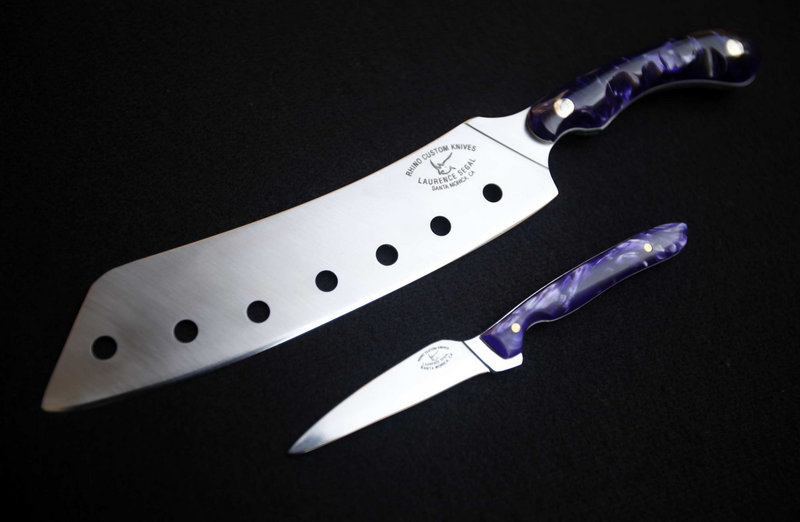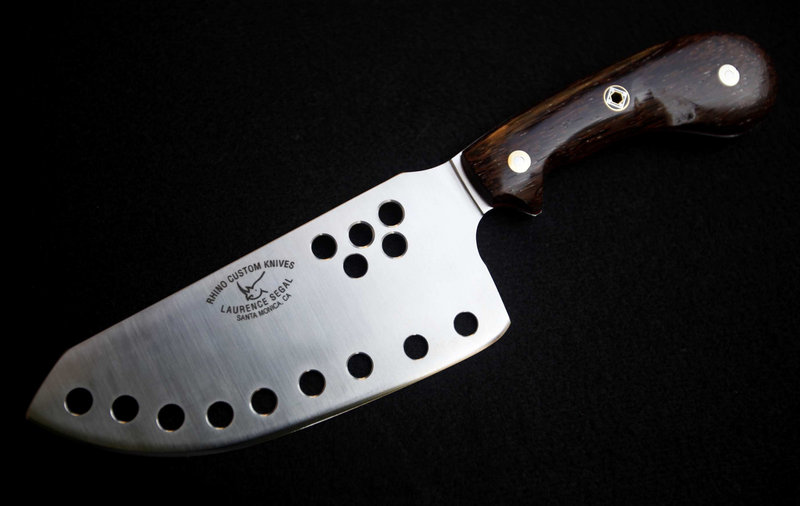If, as the chef Sascha Lyon says, knives are one of the cool toys of his profession, then plenty of amateurs are aiming to play with the pros.
“The choices for a home cook have blossomed,” says Laurence Segal, who opened a shop in September in Santa Monica, Calif., where he makes knives by hand as well as sells other brands and sharpens blades.
“One thing driving the knife market is that people have much more sensitive palates than they used to,” Segal says. That means discriminating eaters can – or say they can – distinguish between food that’s cut or torn with a dull knife and food that’s properly cut.
A second driver is men. More of them are cooking and want the tools to do it, he says.
“I’d agree with that. Men are probably our most prominent buyer of cutlery. And that’s not true with our other products,” says Susanna Linse, a spokeswoman for Sur La Table. “Men love their cutlery.”
A $20 knife with a plastic handle will work just fine, at least for a time. But a $200 knife that’s well cared for can be passed on to grandchildren. And if a $200 knife still seems mundane, there are custom-made knives designed to fit the hand that feeds with it, some that cost thousands of dollars.
Well-chosen culinary knives – rather than whatever a couple happened to get for a wedding gift – have risen significantly in popularity with the boom of television food shows, where chefs could be seen using all sorts of blades, Linse says. And Sur La Table’s knife-skills classes are among the company’s most popular.
In mid- to top-range knives, one choice a cook makes is between Asian-style knives, which generally have thinner blades and are lighter, and heartier European-style knives, which make cutting chicken easier.
Over the last eight years, Linse says, interest in Asian knives has grown, so much so that at one point sales of santoku blades – flat blades with a curve toward the tip – surpassed the traditional European shape.
“That has leveled off, and they’re about head to head,” she says.
John Pitblado, the “knife geek” at Surfas Restaurant Supply & Gourmet Food in Culver City, Calif., agrees: “Our customers are really going back to the traditional-style knife. Nothing beats a good Western chef’s knife.”
But Japanese knives, with the romance of a history dating to the samurai, “are here to stay,” Linse says. Among the popular brands are Shun, with its distinctive oval handle, and the all-steel Global. The Global knife is in the Museum of Modern Art design collection, and it’s “the sexiest look of all of our knives,” Pitblado says.
“People who love it are ga-ga over it. The handle, which is covered with small divots, is filled with sand to give it balance and a substantial feel,” Pitblado says. The Global santoku costs $120.
Surfas also carries the Masahiro brand, which has an “absurdly” sharp edge. “It floats through squash. And it also will float through a finger,” Pitblado says.
Of the European style, popular brands include Wusthof and Henckels. Surfas sells knives from Messermeister; the 10-inch chef’s knife costs $144.
Segal, the Santa Monica knife maker, sells his custom 8- or 10-inch chef’s knife for around $300. His workshop is a jumble of machines and multicolored belts that grind wood handles and steel blades.
At 38, he found himself ready for a new occupation and asked himself what he loved. He answered in part: plants, especially staghorn ferns, the ocean and knives.
So he went to Barnes & Noble, found a book about making knives and got to work in his garage. “I loved it, pretty much from Day 1,” he says. Rhino Custom Knives began 15 years ago and moved to Santa Monica at his wife’s suggestion. “She said, ‘Women would be much more interested in getting their knives sharpened if they didn’t have to meet a strange man in his garage,’ ” Segal says.
Among his custom offerings is a 6.5-inch Rhino Chop. It has holes along the blade and in a butterfly-shape near the handle. The former help keep food from sticking to the blade, the latter enable the cook to get a better grip, Segal says. Segal also incorporates safety features, such as a thumb ramp that provides a surer hold.
He works by stock removal, grinding away what he doesn’t want. After forming the basic profile, he drills the holes and then sends the piece for heat treatment to make it strong but not brittle. Then the blade gets the final finish work, and the handle, one of several exotic hardwoods, is attached. It takes up to 10 hours to make a knife, he says.
The majority of knives sold today have stainless steel blades, but some cooks prefer old-fashioned carbon steel knives, which can have a sharper edge but require more care. They can rust and will develop a patina familiar to anyone using grandmother’s knives.
Earlier this year, Sur La Table introduced a line of carbon steel knives designed by Bob Kramer and made by Zwilling J.A. Henckels; the priciest Kramer knife at Sur La Table is an 8-inch Damascus carbon steel chef’s knife that sells for $1,799. Kramer’s own handmade knives have become so popular that customers must register on his website even for the chance to order.
Experts often recommend against knife sets, because each knife should be chosen to suit the owner’s needs. Home cooks can get by with a chef’s knife, a paring knife or two and a serrated knife for bread.
“Some people really like the feel of a certain kind of handle. How a knife feels in your hand can be very different than in my hand,” Linse says. “If I am with my husband, we’ll have a different experience. He might go toward a 10-inch. I have a 10-inch, but I rarely use it. I use a 6-inch. I prefer the Japanese blade…. I like the weight of the knife, how it feels in my hand.”
The Global is a great knife for vegetarians, Lyon says. “A lot of it is how you respond to the tool. The same way we taste with our eyes…. It’s got to give you a tingle.”
So why would cooks buy a new knife if they own one that can last generations?
“With a new tool you can renew your experience with food,” says Pitblado, owner of a Victorinox, two Globals, a Masahiro and a Henckels.
“I could never have enough knives,” says Lyon, executive chef at Delphine at the W Hollywood Hotel.
His favorite is a wide-blade Wusthof, but he also has a knife with his name engraved that a friend brought from Japan and about 15 inexpensive paring knives. Among the less common blades, he has a 16-inch serrated knife used to cut the bone of a large fish, a one-piece solid metal Japanese cleaver and a couple of Damascus steel knives.
But it’s all relative.
“Nothing like Morimoto has,” he jokes about the Iron Chef.
KEEP KNIVES IN TIP-TOP SHAPE
No matter how good a knife starts out, it won’t cut well or last unless it is well-maintained.
Sascha Lyon, the chef at Delphine, sharpens his knives every day, adding, “I’d never let anyone else touch them.” He makes an exception for the Manhattan shop Korin. He takes some knives there when he goes to New York.
Of course, the stakes are a little higher for Lyon than for home cooks. He recalls how important sharp knives were when he worked at one of New York’s top restaurants, Daniel Boulud’s Restaurant Daniel.
“The fear was that if chef picked up your knife and it wasn’t sharp,” he might toss it in the trash or even break it, Lyon says. “Either way, you were done. You had to have the sharpest knife in the kitchen.”
He says he’s not quite so demanding at Delphine: “I try to be a little softer than I what I grew up with.”
At home, cooks can learn to sharpen their knives on a stone. Or, take them to a professional at least once a year.
Custom knife maker Laurence Segal says a steel can double the time a knife stays sharp. That’s a tool that has a wooden handle and a long, skewer-shaped top. Each time a knife is used, the cook can hone the blade by stroking it along the steel at a 20-degree angle.
Knives should be used only on cutting boards, not on granite or glass; and they should not be washed in the dishwasher, John Pitblado of the store Surfas says.
Store knives on a magnetic strip, either hanging on the wall or in a drawer, or in a flat wood block. A standing wood block also works, though dropping the blades into the slots can wear on the tips.
Send questions/comments to the editors.




Success. Please wait for the page to reload. If the page does not reload within 5 seconds, please refresh the page.
Enter your email and password to access comments.
Hi, to comment on stories you must . This profile is in addition to your subscription and website login.
Already have a commenting profile? .
Invalid username/password.
Please check your email to confirm and complete your registration.
Only subscribers are eligible to post comments. Please subscribe or login first for digital access. Here’s why.
Use the form below to reset your password. When you've submitted your account email, we will send an email with a reset code.